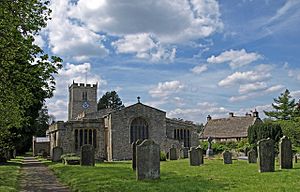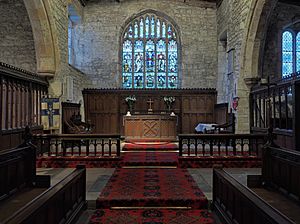Church of St Andrew, Grinton facts for kids
Quick facts for kids Church of St Andrew, Grinton |
|
|---|---|
| St Andrew's Church | |

St Andrew's Church, Grinton
|
|
| 54°22′53″N 1°55′49″W / 54.3813°N 1.9304°W | |
| OS grid reference | SE046984 |
| Location | Grinton, North Yorkshire DL11 6HH |
| Country | England |
| Denomination | Church of England |
| History | |
| Status | Active |
| Architecture | |
| Architectural type | Norman Perpendicular Decorated |
| Administration | |
| Parish | Swaledale with Arkengarthdale (460421) |
| Benefice | Swaledale with Arkengarthdale |
| Deanery | Richmond |
| Archdeaconry | Richmond and Craven |
| Diocese | Leeds |
The Church of St Andrew in Grinton is a very old and important church in North Yorkshire, England. It's the main church for the village of Grinton. People sometimes call it The Cathedral of the Dales because it was once the only parish church in the upper part of Swaledale.
For hundreds of years, people who died in the upper valley were carried all the way to St Andrew's for burial. This long journey was known as the Swaledale Corpse Way. The church building started in the 12th century and has been changed many times since then. It has a mix of old styles, including Norman architecture and Perpendicular designs.
Inside, you can find some special things. There's a Jacobean pulpit, which is a raised platform where the priest speaks. It even has a "sounding board" above it to help the sound carry. The church also has a rare "chained bible" and a "hagioscope," which is a special opening in the wall.
Contents
History of St Andrew's Church
How the Church Began
The Church of St Andrew was first built in the 12th century. It was given to a group of monks called the Augustinians from Bridlington Priory. These monks owned a lot of land around Grinton. Before this church was built, the area was part of a parish that stretched all the way to Catterick.
People believe there might have been an even older Saxon church on the same spot before St Andrew's was built. At first, Augustinian monks looked after the church. They called it Ecclesia de Swaledala. Later, in the late 1200s, a local priest called a vicar was appointed.
Changes Over Time
Over the centuries, the church building has been changed and added to many times. New parts were built in the 13th, 14th, 15th, and 16th centuries. The church has a tower, different sections called aisles, a main area called the nave, and special chapels.
A famous expert on buildings, Pevsner, described St Andrew's as a "low, grey, spreading Perpendicular church." This means it's built in a style called Perpendicular, but it also has older Norman and Decorated styles mixed in. It's known as one of the most northern "Pennine Perpendicular churches."
Special Features Inside
The main part of the church is about 89 feet long and 54 feet wide. The pulpit, where the priest gives sermons, is from the Jacobean period. In 1718, a sounding board was added above it. This board helped the priest's voice reach everyone in the church.
Another interesting feature is the hagioscope, also called a "squint." This is a small opening in the wall. It allowed people to watch the church service even if they couldn't be in the main part of the church. Sometimes, it was used by people who had illnesses like leprosy. This way, they could still be part of the service without spreading their sickness.
The church porch has grooves in its stone. Some people think these were made by men sharpening their arrows while waiting for the lords to finish church before going hunting.
Renovations and Updates
St Andrew's Church was fully renovated between 1895 and 1896. This cost about £3,000. During this time, old "box pews" (like small private boxes) were removed and replaced with normal pews. Many of the old stained glass windows were kept, but some new ones were added. One beautiful new window was made by Charles Eamer Kempe.
At the same time, the church bells were remade, and the tower got a new clock. The old Norman font, which is a basin used for baptisms, was also brought back into the church.
The Swaledale Corpse Road
Because St Andrew's was the only church in Upper Swaledale with consecrated ground (blessed ground for burials), people from villages like Muker and Keld had to carry their dead relatives about 12 miles down to Grinton. This path became known as the Swaledale Corpse Road.
This tradition ended in 1580 when a new church, St Mary's, was built in Muker with its own consecrated ground. However, it took another 300 years for Muker to get its own parish. Before that, Grinton Parish was the largest in Yorkshire for 400 years! Its large size and importance led to its nickname, The Cathedral of the Dales.
Bats in the Church
St Andrew's Church is also home to a colony of bats. Bats are protected animals, so even though they can cause some damage, the community has learned to live with them. The bats are even used as a way to teach schoolchildren about wildlife and conservation.
The Chained Bible
One of the most special items in the church is its chained bible. In 1752, it was marked with the words: "for the use of the inhabitants of Grinton, 1752." Chaining books in churches was an old way to make sure valuable books stayed safe.
King Henry VIII supposedly ordered churches to have a chained bible on display. Later, King Edward VI also said that churches should have a large English bible "to be sette upp in some convenient place within the churche." By the early 1900s, only two churches in the old North Riding of Yorkshire still had a chained bible: St Andrew's and St Michael's at Kirklington.
Other Important Buildings Nearby
Besides the church itself, which is a very important grade I listed building, there are three other listed structures connected to it:
- Blackburn Hall: This building is grade II* listed. It was originally used by the monks from Bridlington Priory as a house.
- The Clarkson memorial: This memorial is in the churchyard and is grade II listed.
- The gates and gatepiers: The gates and stone pillars at the east side of the church are also grade II listed.
The Church Community
St Andrew's is one of four churches in the local church area called Swaledale with Arkengarthdale. The other three churches are St Mary's in Muker, Holy Trinity in Low Row, and St Mary's in Arkengarthdale. These churches work together as one community.
Clergy of St Andrew's Church
The person in charge of the church is called the vicar. The current vicar, Caroline Joan Hewlett, also looks after the other churches in the Swaledale with Arkengarthdale area.
Here is a list of some of the vicars who have served at St Andrew's Church over the centuries:
| Year | Incumbent | Year | Incumbent | Year | Incumbent | ||
|---|---|---|---|---|---|---|---|
| 1272 | Symon de Swaldal | 1587 | Henry Simpson | 1892 | David Walker | ||
| 1278 | Adam | 1623 | George Simpson | 1899 | Joseph John Merry | ||
| 1362 | Symon de Nesse♦ | 1634 | Edward Norton | 1907 | Bertrand Gregory | ||
| 1397 | William de Darlington | 1637 | Thomas Gent | 1925 | John Shaw Harrison | ||
| 1411 | Roger Ward | 1658 | Francis Atkinson | 1930 | Edward Norman Spear | ||
| 1425 | Thomas Swaldale | 1673 | Tobias West | 1932 | Gerald Farrington | ||
| 1448 | Roger Clyff | 1717 | Thomas Lightfoot | 1938 | Edward Somerset | ||
| 1465 | John Bramsfeld | 1742 | Timothy Dickinson | 1944 | Herbert John Kingsley | ||
| 1474 | Nicholas Duke | 1783 | Thomas Jay | 1952 | Charles William Clarke Richards | ||
| 1524 | John Smyth | 1799 | Thomas Edmondson | 1959 | Wilfrid Michael Case | ||
| 1535 | William Dowson | 1822 | Henry Burdett Worthington | 1985 | Peter Stanley Midwood | ||
| 1564 | Matthew Browne | 1842 | Elias Tardy | 1998 | Timothy Mark Tunley | ||
| 1585 | Alexander Stocks | 1850 | Charles Porter | 2006 | Caroline Joan Hewlett | ||
| 1587 | Henry Simpson | 1855 | Percy Smith |
- ♦This symbol means there might be missing information or a gap in the records for that time.
See also
- Grade I listed buildings in North Yorkshire (district)
- Listed buildings in Grinton




